==================
Florida Splendors is supported by our audience. When you purchase through one of our links, we may earn a small affiliate commission. As an Amazon Associate I earn from qualifying purchases. Your cost is not affected.
Wings of Florida: Exploring Wild Parrot Populations in Florida takes you on a captivating journey through the Sunshine State’s lush landscapes and introduces you to the vibrant and unexpected inhabitants that call it home. In this enchanting exploration, we will explore the colorful world of wild parrots in Florida. Join us as we soar through the skies and venture into the wild, discovering the incredible stories behind these feathered Floridians.
How Did Wild Parrot End Up in Florida?

Those wild parrots in Florida? Well, they’re the descendants of escaped or released pet birds. The pet trade has been the main way these non-native parrots ended up in the United States and other parts of the world.
Now, there are many reasons folks might set their pet parrots free. Some might not be able to care for them anymore, while others think they’re doing the parrots a solid by letting them roam wild. But here’s the thing: releasing these exotic pets into the wild can cause problems for the parrots and the local ecosystem.
For one, parrots set loose in the wild often struggle to find food and shelter, and they can become easy prey for other animals. Plus, they end up competing with native birds for resources. Unfortunately, these parrots can even spread diseases to the local bird population.
But here’s the twist: many parrots survive and thrive in Florida’s wilds despite the challenges. That’s partly thanks to the state’s warm weather and plenty of food. Plus, parrots are incredibly smart and adaptable birds, which gives them a leg up when making it in their new environment.
Is Florida a Good Habitat for Wild Parrots?
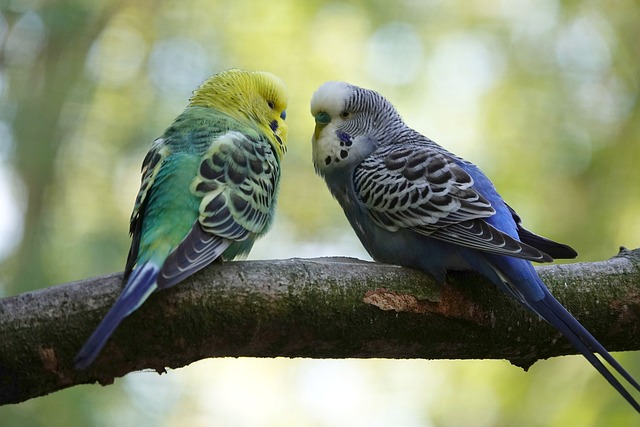
Florida is like a paradise for those wild parrots. It has all the bells and whistles these feathered fellows need to thrive. Here’s why it’s such a primo habitat for them: First, that warm Florida climate is just what the doctor ordered for parrots. These birds are originally from tropical and subtropical areas, so they feel at home in the state’s balmy weather.
And then there’s the buffet of food options – Florida’s like a smorgasbord for parrots. They’ve got a whole spread of treats: fruits, nuts, seeds, and even insects. Talk about a gourmet bird menu!
Plus, when it comes to nesting, Florida’s got it covered. Parrots in Florida often set up shop in tall trees, and guess what? Florida has many palm trees and tall varieties, making perfect real estate for these birds.
So, you see, it’s like the stars aligned for these parrots in Florida – the weather’s just right, there’s food aplenty, and cozy nesting spots galore. It’s no wonder they’ve made it their home sweet home!
Parrot Species Living in Florida
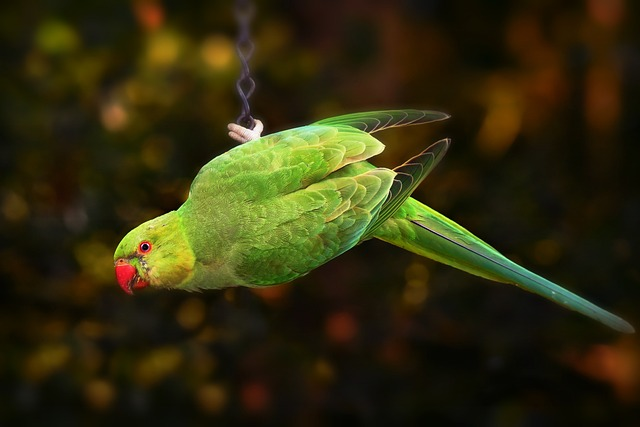
You know what’s interesting? Most of these parrots in Florida are originally from somewhere else. Nope, they’re non-native and made their way to the Sunshine State thanks to the pet trade, whether by accident or on purpose. Pretty wild, huh? Now, if you’re curious about who the usual suspects are in the wild parrot lineup in Florida, here’s a little sneak peek:
Blue-and-Yellow Macaw
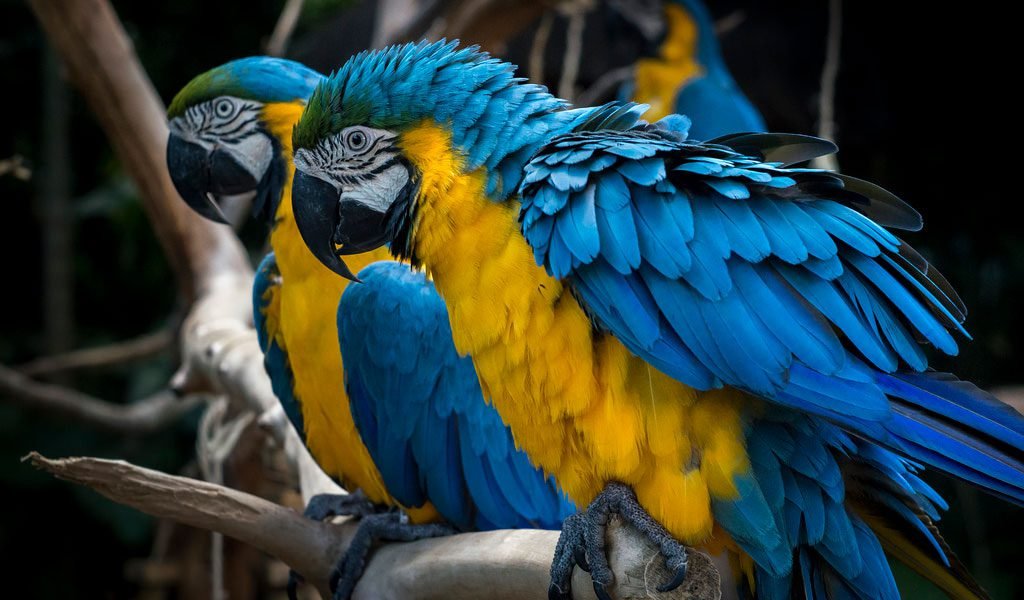
Photo By: Animal Corner
These avian creatures are the larger-than-life parrots in Florida, boasting wingspans that reach an impressive 4 feet. Their striking appearance includes vibrant blue plumage adorning their backs and wings, while their chests and bellies sport a cheerful, sunny yellow hue. Their heads are all green, and they sport a black beak and a white face.
Blue-and-yellow macaws aren’t loners. Nope, they’re social butterflies and like to hang out in flocks, sometimes even with up to a hundred of their feathered friends. Plus, they’ve got brains to match their beauty. These birds are super smart and can be trained to chat and do tricks. In Florida, you’ll spot these macaws in the urban and suburban areas and chilling in woodsy spots near water.
Blue-Crowned Parakeet
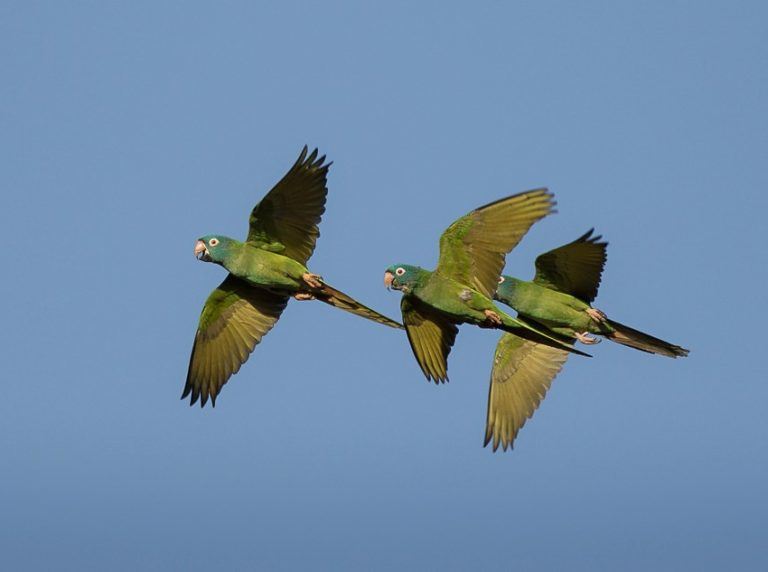
Photo By: birdfinding.info
The blue-crowned parakeet (thectocercus acuticaudatus) is originally from South America. It has established feral populations in several cities in southern Florida, including Miami, Fort Lauderdale, and West Palm Beach.
Blue-crowned parakeets are bright green birds with a blue crown, face, distinct white eye-ring, and long, pointed tails. They are typically about 12 inches long from head to tail. They’re social butterflies and prefer the company of their pals. You might catch them hanging out in flocks of up to 100 birds. They’re also open to homes; they can do just fine in the city or the suburbs.
In Florida, you’re most likely to spot these parakeets in parks, gardens, and any lush green spaces they can find.
Black Hooded Parakeet
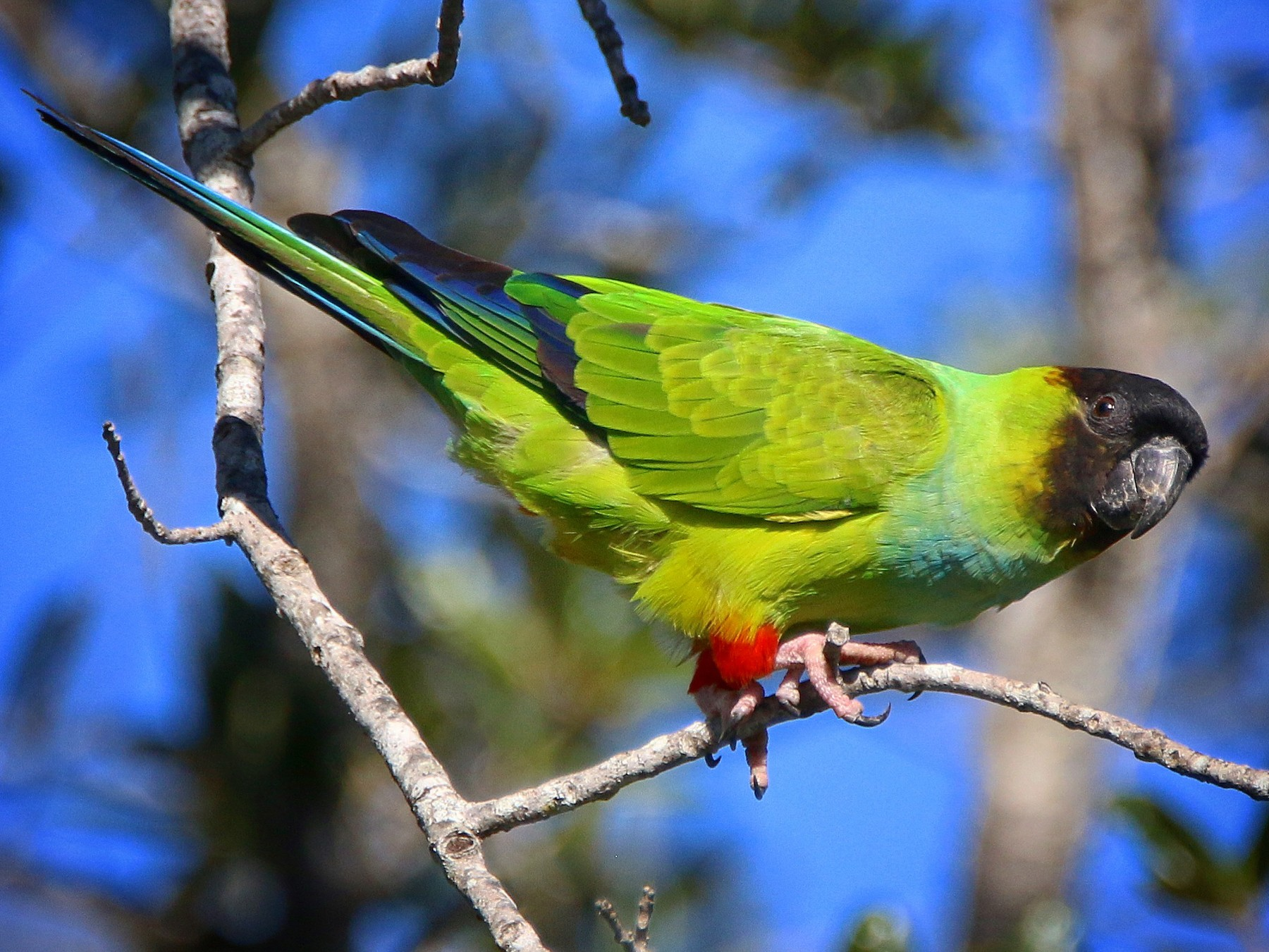
Photo By: eBird
Black-hooded parakeet, also known as the Nanday Conure. These medium-sized parrots originally come from central South America, but they decided to make a pitstop in Florida, thanks to the pet trade. Now, they’ve yet to stop by; they’ve set up a happening scene in the state! They’re about 11-12 inches long, not too big. You can spot them by their mostly green feathers, but their head, beak, and the feathers at the tip of their wings are jet black. Oh, and their tail has a striking blue edge. When you look at their upper chest, it’s got a bluish-green thing going on, and the lower chest is a bit of a lighter green. If you check out their thighs, you’ll see they’ve got some red feathers, adding a little flair to their style.
Nandays have distinct voices and bright personalities in the wild and in captivity. They are capable of acquiring a vocabulary of up to 20 words and possess impressive memory skills. These exquisite parrots have formed thriving communities in various locations, notably in the Tampa Bay Area, with a significant presence in St. Petersburg, as well as along the southeastern coast, including Miami.
Budgerigar
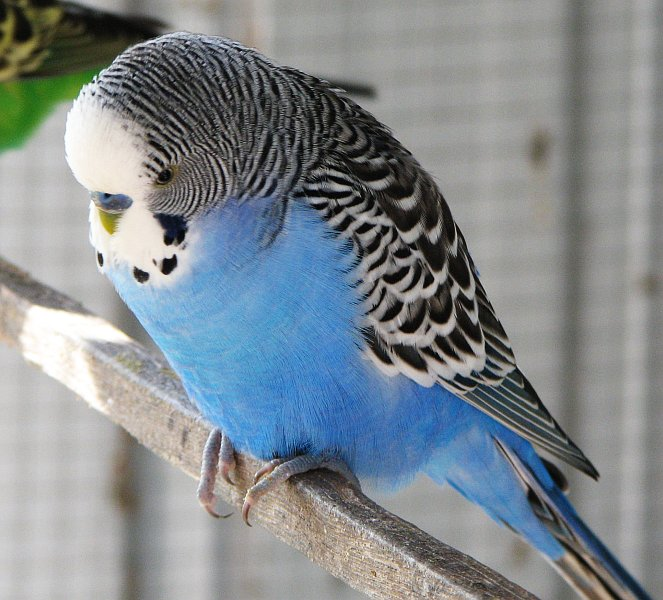
Photo By: Wiktionary
The budgerigar, known to some as common parakeets or simply budgie, is like the pint-sized parrots in the avian realm. These adorable birds have their origins in the land Down Under, Australia. But guess what? They’ve also made their way to the sunny state of Florida, thanks to some escape artist pets! These birds have formed colonies on Florida’s west coast (Gulf Coast) from Crystal River to Fort Myers and the east coast of Fort Lauderdale.
Chestnut-Fronted Macaw
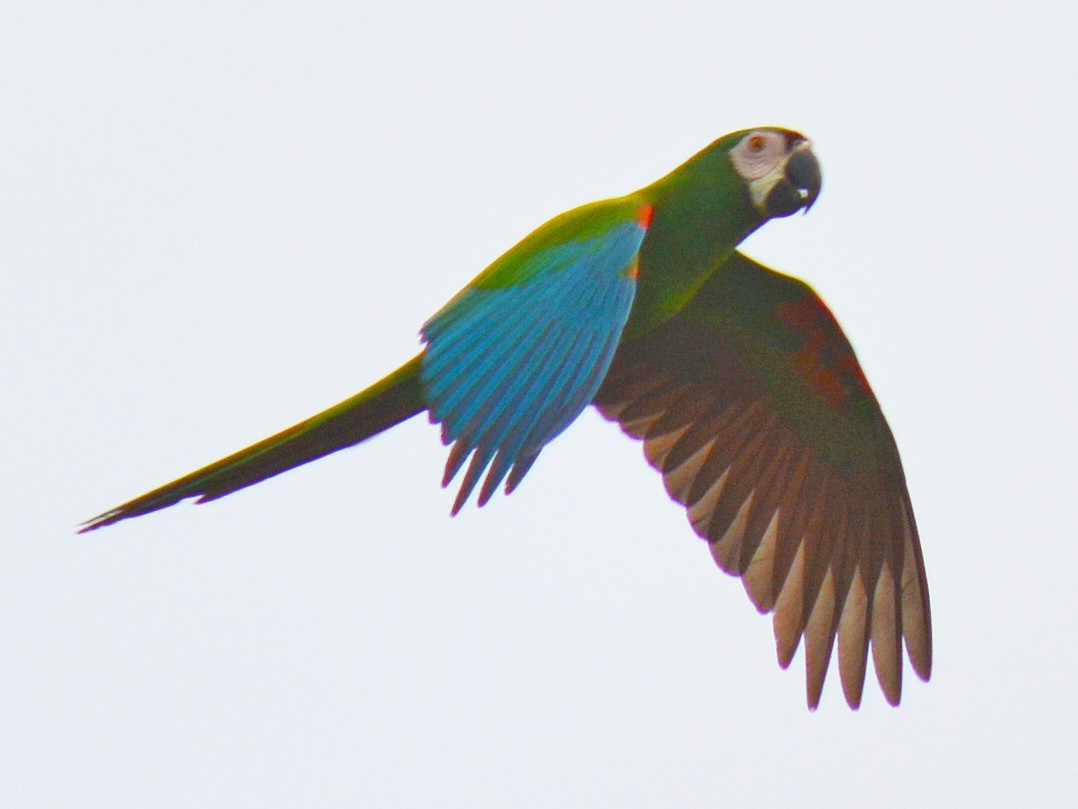
Photo By: eBird
The chestnut-fronted macaw, a small macaw originally from central and south America in Florida, is like the regulars at a local hangout. Measuring about 18 inches from head to tail. The Chestnut-fronted Macaw displays a distinctive appearance with a greenish body and reddish-brown underwings, striking deep blue primaries, and a lengthy pointed tail adorned with hints of blue at the outer tips and chestnut on the inner section. These macaws feature a bare, white facial patch on their heads, complemented by a touch of chestnut feathers on the forehead, all surrounding a large black bill.
They’re not the loner type; chestnut-fronted macaws are all about the social scene. You’ll often find them chilling in flocks, sometimes with about 20 of their buddies. These birds aren’t picky when it comes to habitat either – they’re into forests and savannas and even hang out in the agricultural areas. And when it’s mealtime, they’re up for a feast, chowing down on fruits, nuts, seeds, and even insects.
Green Parakeet

Photo By: eBird
Green parakeet, also known as the green-rumped parakeet. These little guys are originally from South America, but they’ve spread their wings and made their way to various parts of the world, including sunny Florida, where they’ve set up shop and gone feral. Now, when it comes to their stats, green parakeets are about 12 inches long, from their cute little heads to their tail feathers.
When they stretch their wings, you’re looking at a wingspan of roughly 23 inches. So, they’re not the biggest parrots around, but they have their charm. As for their appearance, their body is a greenish and they’re decked out in vibrant green feathers, and if you look closely, you’ll notice their rump and tail are a darker shade of green. If you’re planning a bird-watching trip, keep your eyes peeled around Fort Lauderdale and Miami in Florida because that’s where you’re likely to spot these green parakeets.
Mitred Parakeet
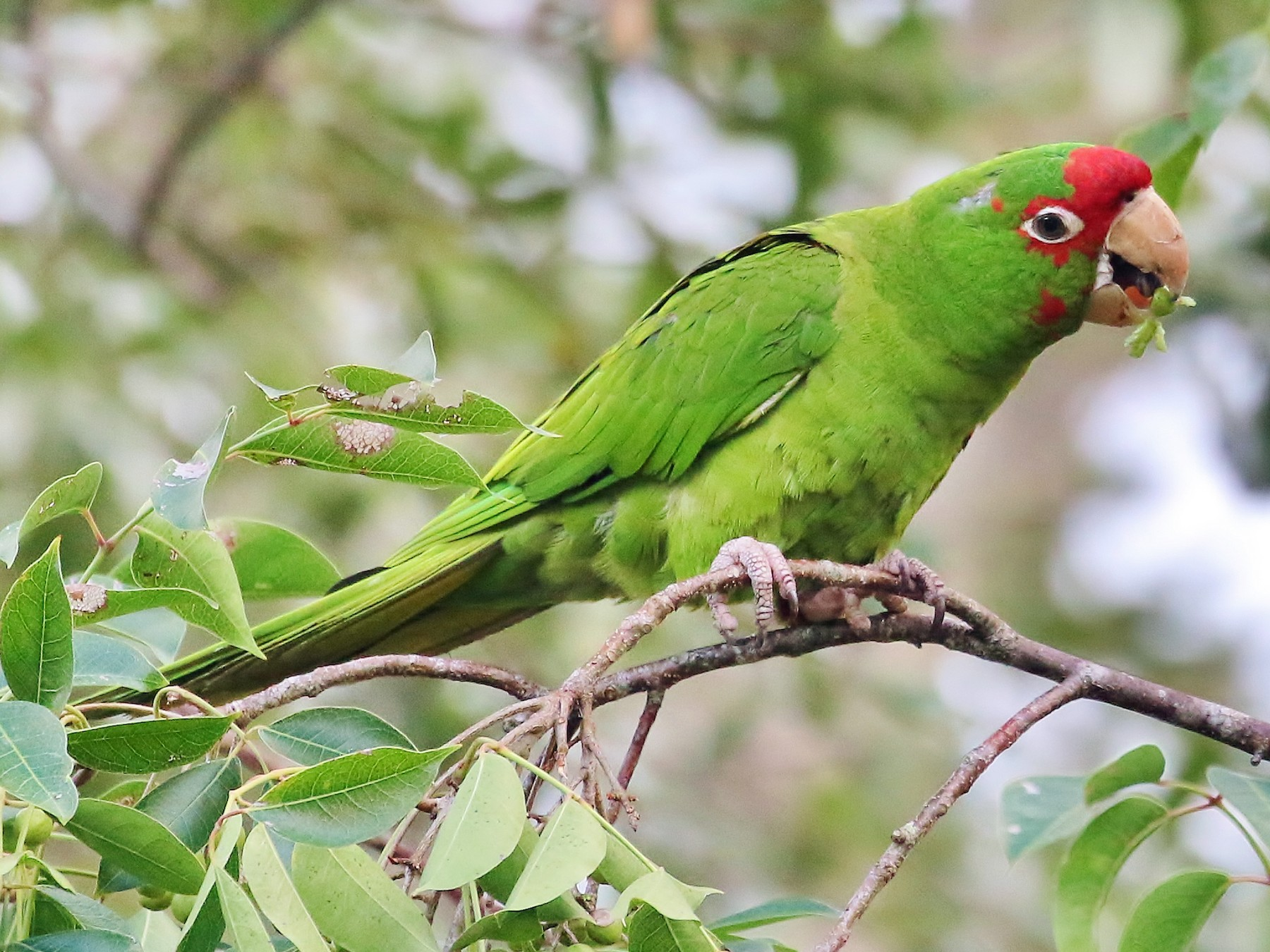
Photo By: eBird
Mitred parakeets are medium-sized parrots originally hailing from the Andes of Peru, Bolivia, and Argentina. But here’s the twist – they’ve taken a detour to Florida thanks to the pet trade and set up shop in the state’s southeastern part, mostly hanging out in Miami-Dade County.
These parakeets aren’t the giants of the bird world, measuring in at about 12-15 inches from head to tail. You can spot them by their mostly green feathers, but they have some cool features like a red forehead and crown.
Within Florida, these parakeets are primarily located in the southeastern regions of the state, with a notable presence in Miami. They inhabit similar environments as the Red-masked parakeets, often congregating around exotic plantings in suburban areas and parks. Additionally, there have been sightings of them utilizing cavities and chimneys in buildings for roosting and breeding.
Monk Parakeet
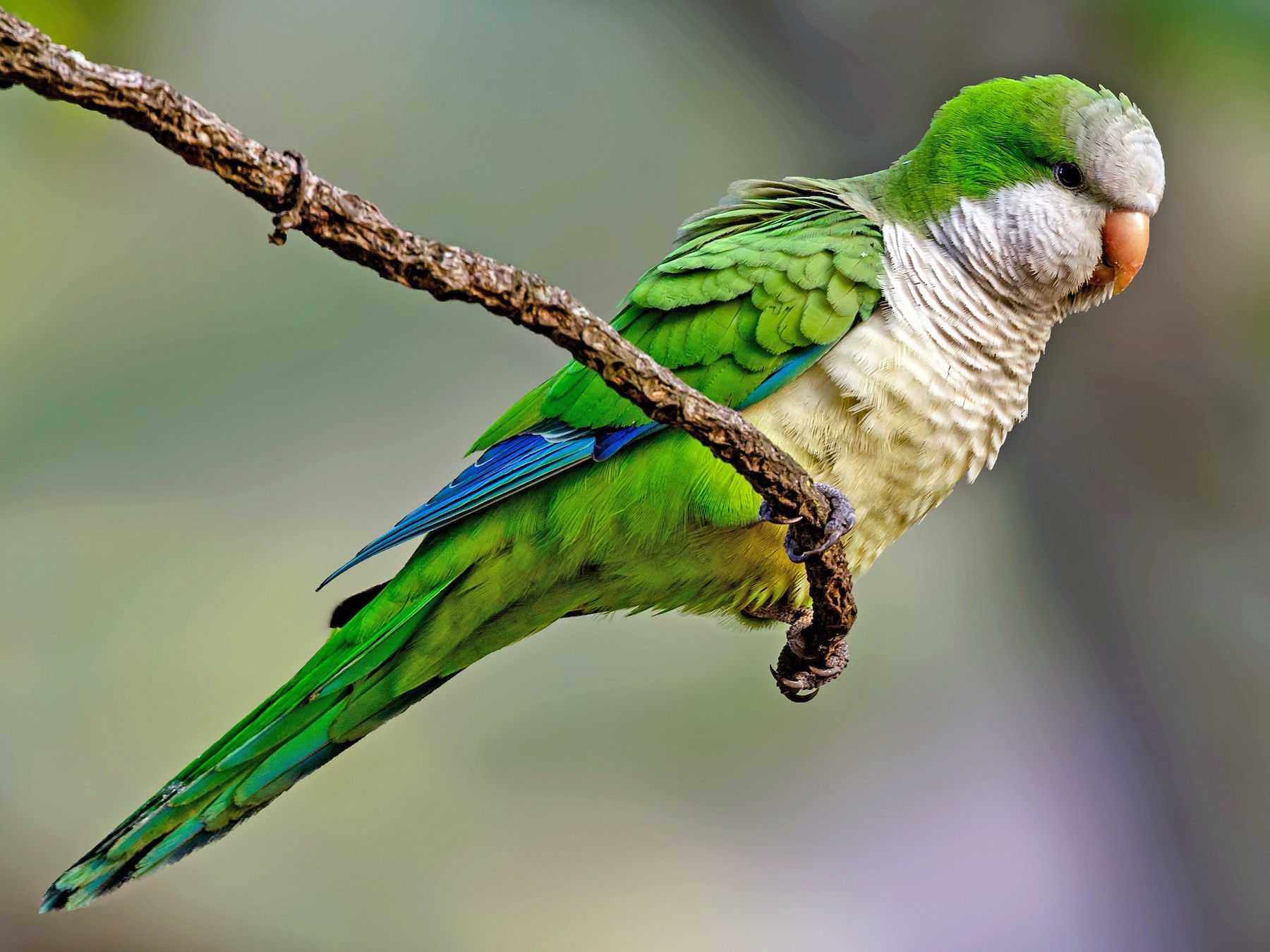
Photo By: eBird
The monk parakeet, also known as the Quaker parrot, is a small and vibrant green parrot with a touch of grey on its chest and a yellowish-green belly. These little birds belong to the true parrot family Psittacidae and can live for about 20 to 30 years. They originally come from the temperate to subtropical regions of South America. Interestingly, they’ve managed to establish wild populations in various places, particularly in areas with climates similar to their native habitat, including parts of North America and Europe.
Now, when it comes to their social life, these monk parakeets are the life of the party. They’re all about the buddy system and like to hang out in flocks. Interestingly, unlike many other parrot species that love cozy tree cavities, these monk parakeets are like architects. Like a real estate venture, they build their nests from sticks and twigs. Each pair in the group has its pad, with at least two chambers to call home. And as the gang grows, they keep adding more rooms to the main nest. They’re not shy around humans either, so you’ll find them living it up in small and big towns and on farms and orchards. These monk parakeets sure know how to blend into the neighborhood!
Orange-Winged Parrot
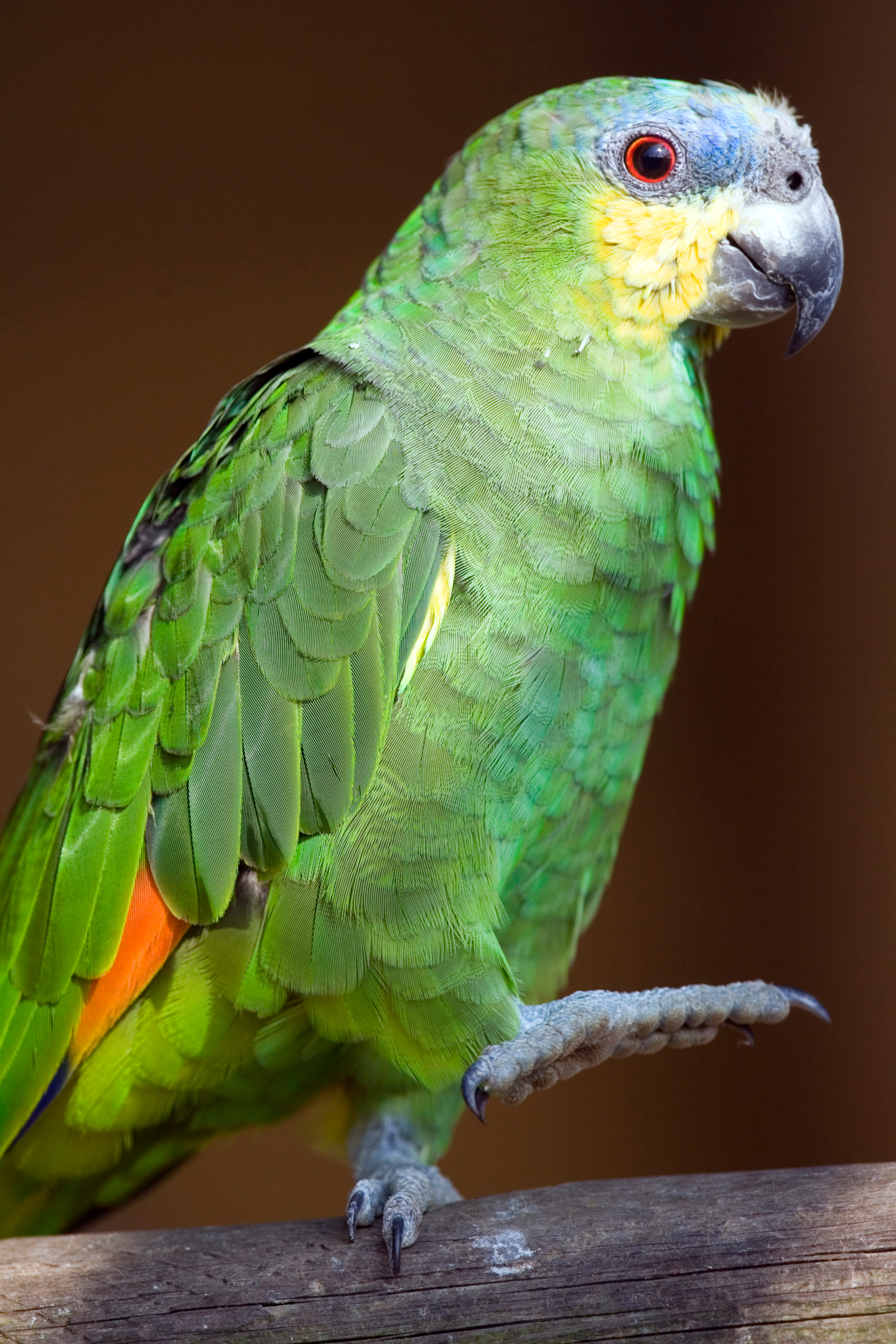
Photo By: Folly Farm
The striking orange-winged birds are on the larger side of the parrot family and are originally from Central and South America. When it comes to their size, these parrots are not lightweight. They stretch out to about 18 inches from their head to the tip of their tail, and when they show off their wings, you’re looking at a wingspan of around 30 inches. As for their looks, they’re decked out in vibrant green feathers, and if you peek at their face, you’ll spot a cool blue mask. They have a regal yellow cheeks, and what sets them apart is that large orange-red patch on the inner wings. It’s like a burst of color on this already stunning bird.
Red-Crowned Parrot
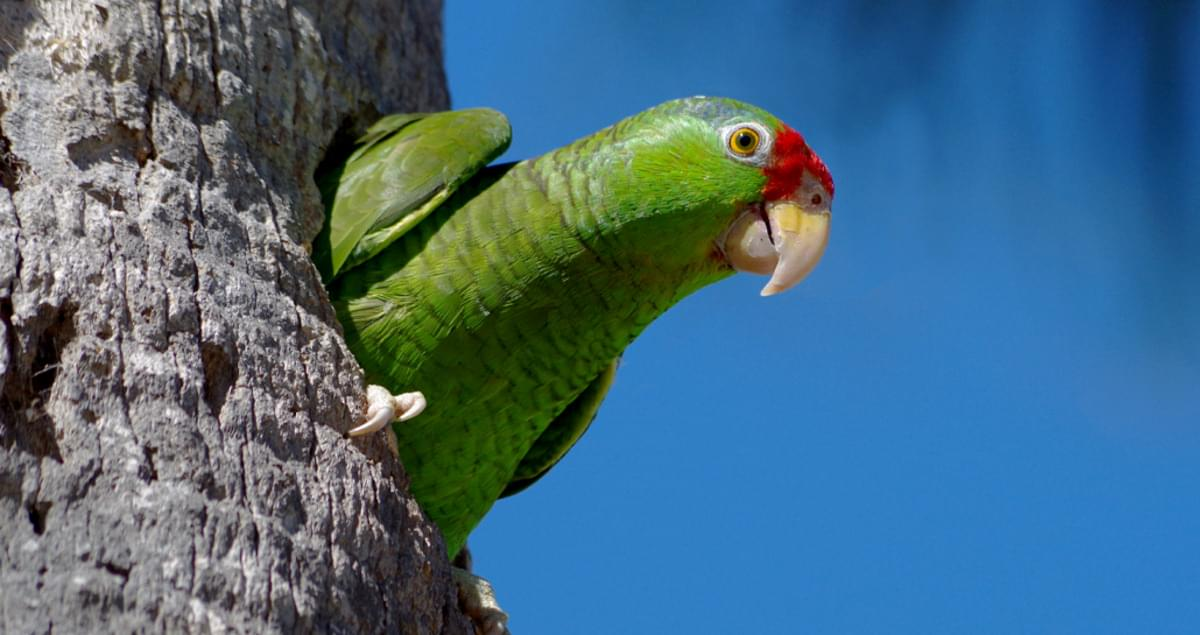
Photo By: All About Birds
This vibrant parrot is also known as the Green-cheeked. These birds are often described as a bit on the stocky or chunky side, and they’ve got this standout feature – a striking red crown with a dash of blue just behind their eyes. Now, here’s a little gender difference for you: the males of this species tend to show off more of that fiery red color, stretching from their bill right up to the crown of their head. Meanwhile, the females keep it mostly between the eyes. Their wings also boast a cool red patch and dark blue tips, and if you check out their tail, you’ll spot a yellowish band at the end. But here’s the deal with these Red-crowned Parrots – they’re known for being quite noisy.
Red-Lored Parrot
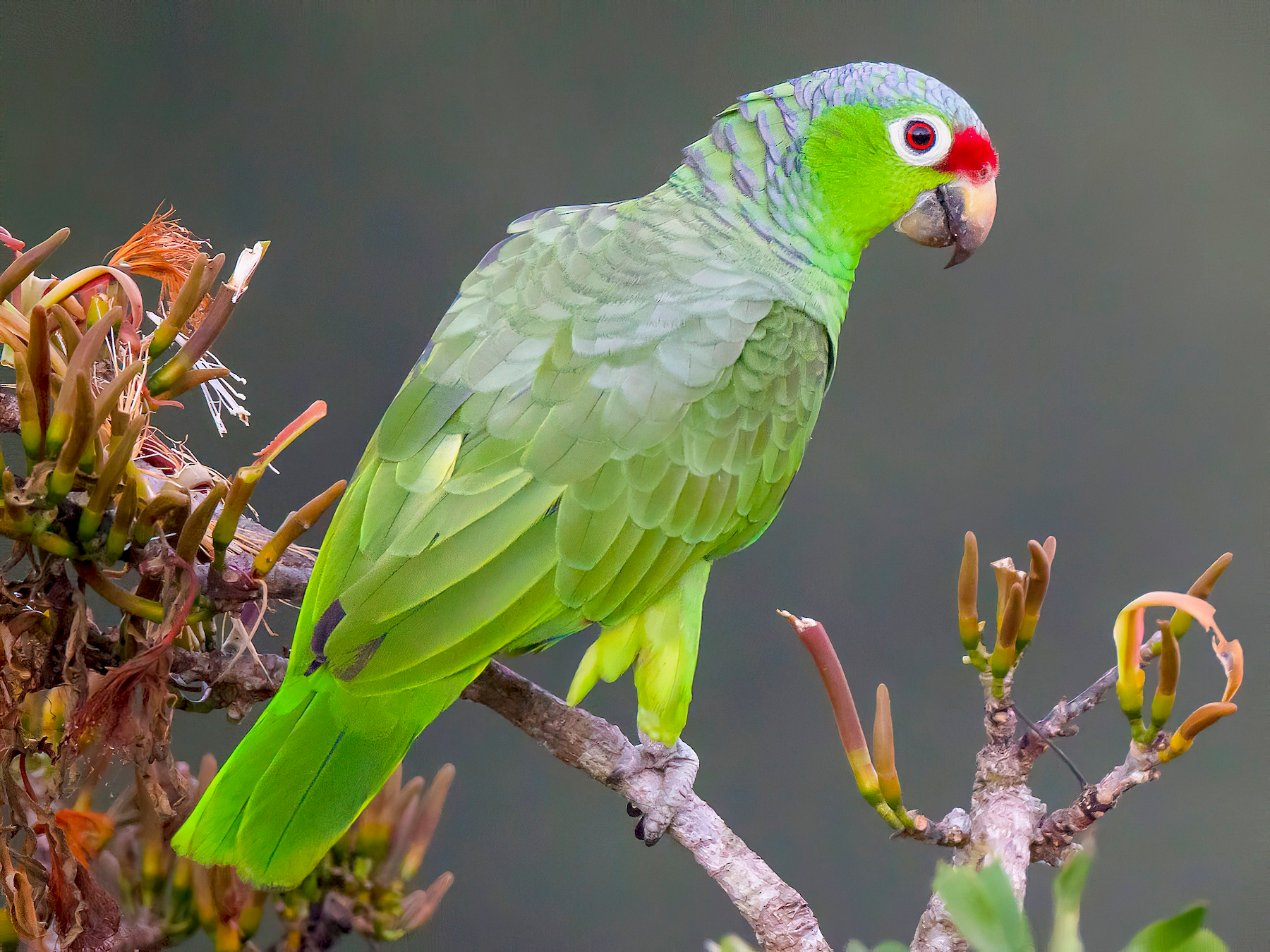
Photo By: eBird
The red-lored parrot calls the tropical regions of the Americas home, stretching from eastern Mexico down to Ecuador. When it comes to size, they’re around 14 inches long from head to tail and boast a wingspan of about 15 to 17 inches. The bird’s feathers are mostly green, and it has a red forehead. Some types of this bird also have yellow cheeks, and you might see red spots on them. On top of its head, it’s blue. It’s interesting that adult males and females look the same. When they’re young, they have fewer yellow patches on their cheeks, less red on the forehead, and their eyes are dark.
Red-Masked Parakeet
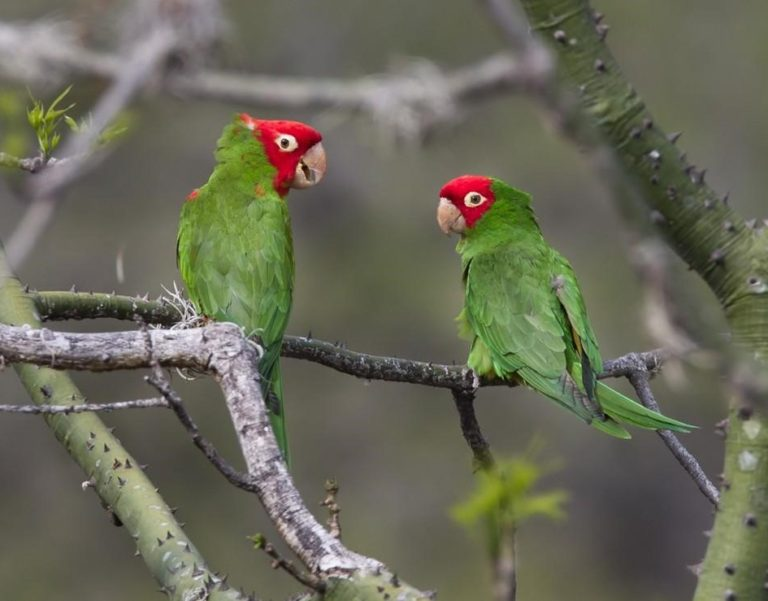
Photo By: birdfinding.info
The vibrant and eye-catching red-masked parakeet is originally from northwestern South America. Now, in terms of size, they measure around 14 inches from their head to their tail, and when they stretch out their wings, you’re looking at a wingspan of about 28 inches. These parakeets are rocking bright or darker green feathers, but what makes them stand out is the superhero-style red mask on their face.
Now, these red-masked parakeets aren’t the shy type. You’ll often find them hanging with their mixed flocks, the Mitred Parakeet, which looks similar. Instead of wild habitats, they prefer the lush surroundings of suburbs and parks with exotic plantings.
Rose-Ringed Parakeet

Photo By: eBird
The Rose-ringed Parakeet, also recognized as the Ring-necked Parakeet, has emerged as a notable presence in Florida, somewhat like an unexpected guest. Originally, these guys call southern Asia and central Africa home, but they’ve packed their bags and spread their wings to many other corners of the world, including the good old United States. The first Rose-ringed Parakeet was spotted in Florida back in 1969, and let’s say they’ve made themselves right at home since then.
Picture these parakeets as medium-sized with a stylish long tail. They’re mostly green, but what makes them pop is that bright red beak and eye-ring. Now, the guys in the group sport a black collar and a head like a fireworks display featuring shades of blue and pink at the nape. On the other hand, the ladies go for a more understated look, with a less colorful head and a touch of greenish-blue at the nape.
These parakeets aren’t picky about where they hang their feathers – they’re like the ultimate adaptability champs and can thrive in all habitats.
White-Eyed Parakeet
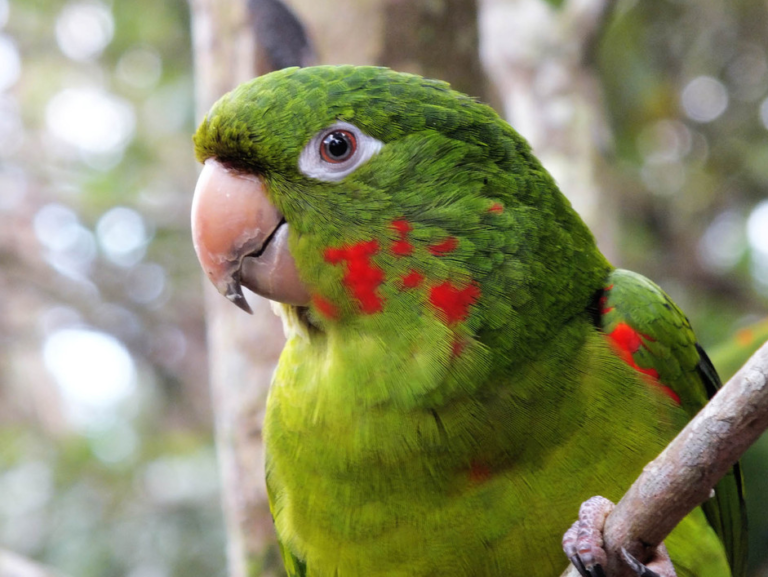
Photo By: birdfinding.info
The white-eyed parakeets are about 12 inches long from head to tail, and their wingspan stretches roughly 23 inches. Imagine a medium-sized parakeet with a sleek, long tail that fans out at the end. These birds rock a mostly green body, but they’ve got a dash of pizzazz with red spots sprinkled across their head, neck, and shoulders. Look closely, and you’ll notice they have these cute, white eye rings and a light-colored bill.
These white-eyed parakeets have made themselves right at home in Florida, particularly in the greater Miami area. You’ll find them nesting in various places, like cavities in buildings and under eaves. They’re resourceful when finding cozy spots to call home.
White-Winged Parakeet
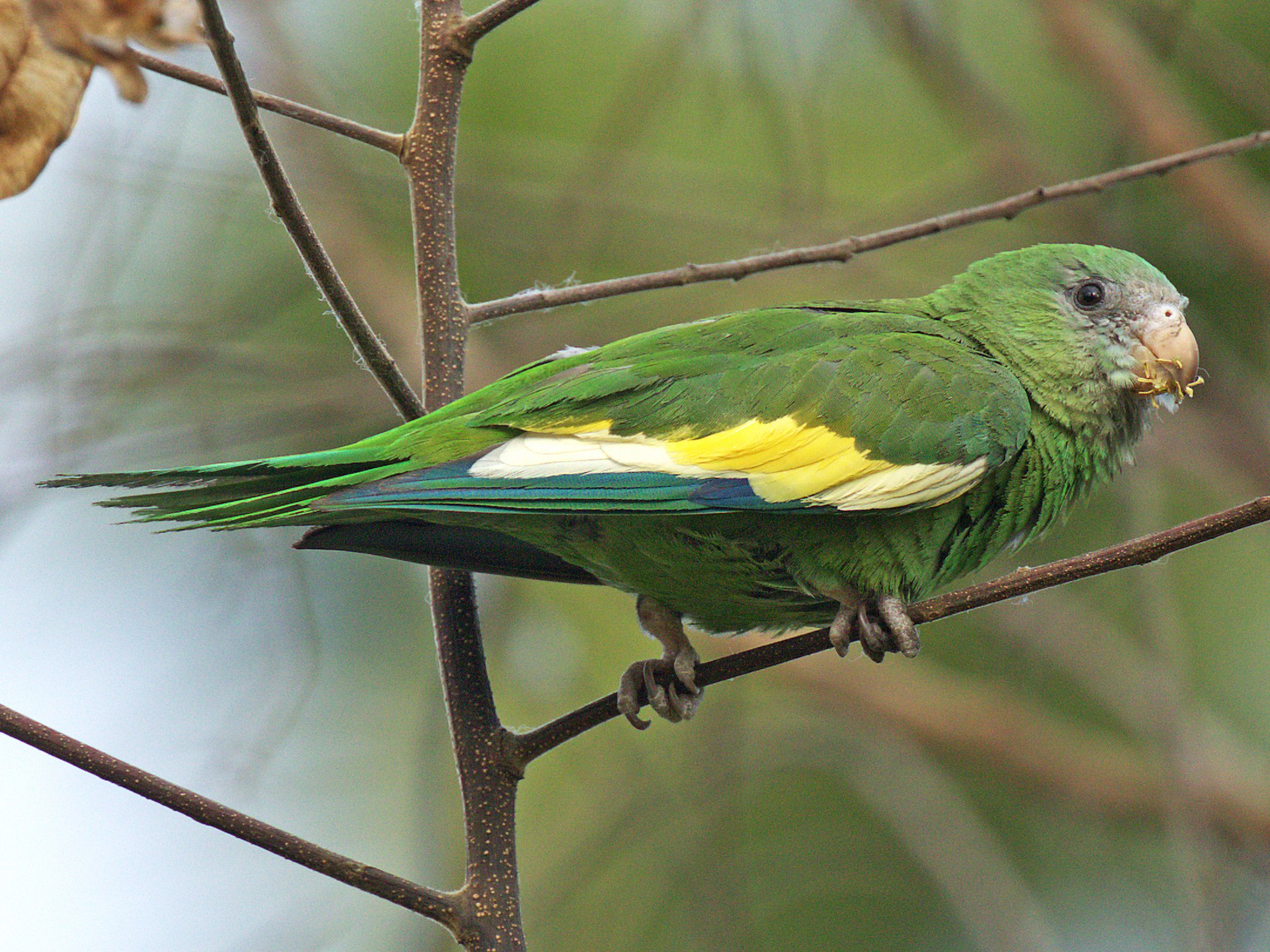
Photo By: eBird
Picture a little bright green parakeet on the small side and catch your eye with its stunning white-and-yellow wing pattern. You can spot this pattern when they’re in flight, making them quite the spectacle. They sport a long, pointy tail. You’ll often find these little guys hanging out in small flocks when you’re out looking for them. They’re flexible when it comes to their habitat so you can spot them in wooded areas or even suburban neighborhoods. And when you’re close enough to hear, listen out for their harsh, high-pitched calls. It’s their way of saying hello!
Yellow-Headed Parrot
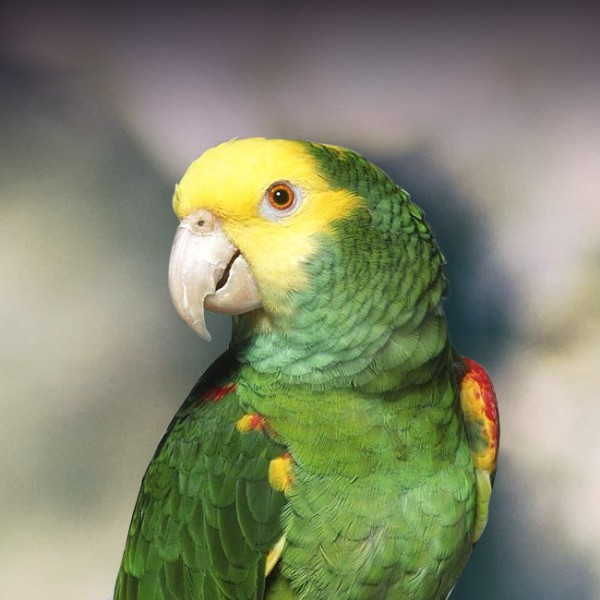
Photo By: Lafeber Company
The Yellow-headed parrot is a unique bird with some interesting characteristics. In terms of size, they measure about 14 inches in length and weigh in at around 15.8 ounces. When they spread their wings, you’re looking at a wingspan of approximately 28 inches. Now, what makes these parrots stand out is their eye-catching appearance. Picture this: they’ve got a bright yellow head and striking red shoulders. Quite the fashion statement, right? When it comes to their flying style, they’re different from most parrots.
They tend to stay fairly quiet when up in the air, which sets them apart from their more chatty feathered friends. But when they do decide to make some noise, watch out! Their screams can sound surprisingly human-like. Now, here’s the not-so-great news – Yellow-headed Parrots are endangered. They’re on the CITES Appendix I, which means it’s illegal to import or trade wild-caught birds of this species. Even the trade of birds bred in aviculture (breeding in captivity) is closely regulated in most parts of the world. So, while they might be captivating creatures, they also need some protection to ensure their survival.
Yellow Chevroned Parakeet
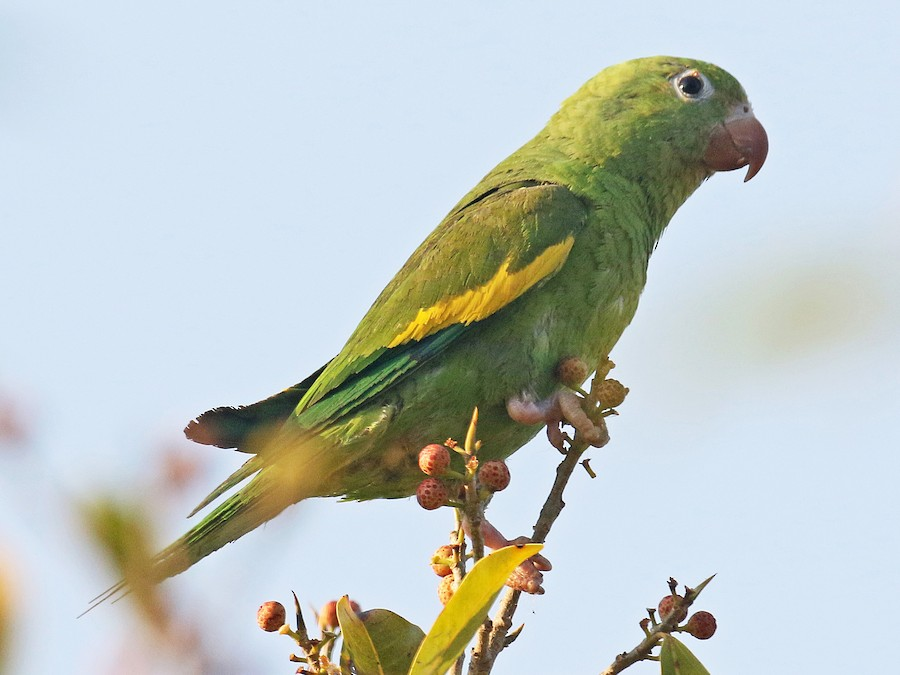
Photo By: eBird
The yellow-chevroned parakeets are small, colorful parrots native to the tropical landscapes of South America. Imagine a small parakeet with a sleek, long, pointed tail and a few standout features – prominent white eye-rings and a short pale bill. Their bodies are predominantly green, but what catches your eye is this distinctive yellow border that separates the darker flight feathers from the paler inner wings. It’s like a touch of sunshine on their wings! When you encounter these lively birds, they usually hang out in lively groups. You’ll hear them before seeing them, as they’re quite chatty.
They prefer savanna woodlands as their hangout spots, but don’t be surprised if you spot them venturing into urban areas occasionally. Here’s an interesting tidbit: these little parakeets are doing pretty well in their population size and overall stability compared to some of their parrot pals, like the White-wings. So, they’re colorful and holding their own in the wild!
Is It Legal to Sell Parrots in Florida?
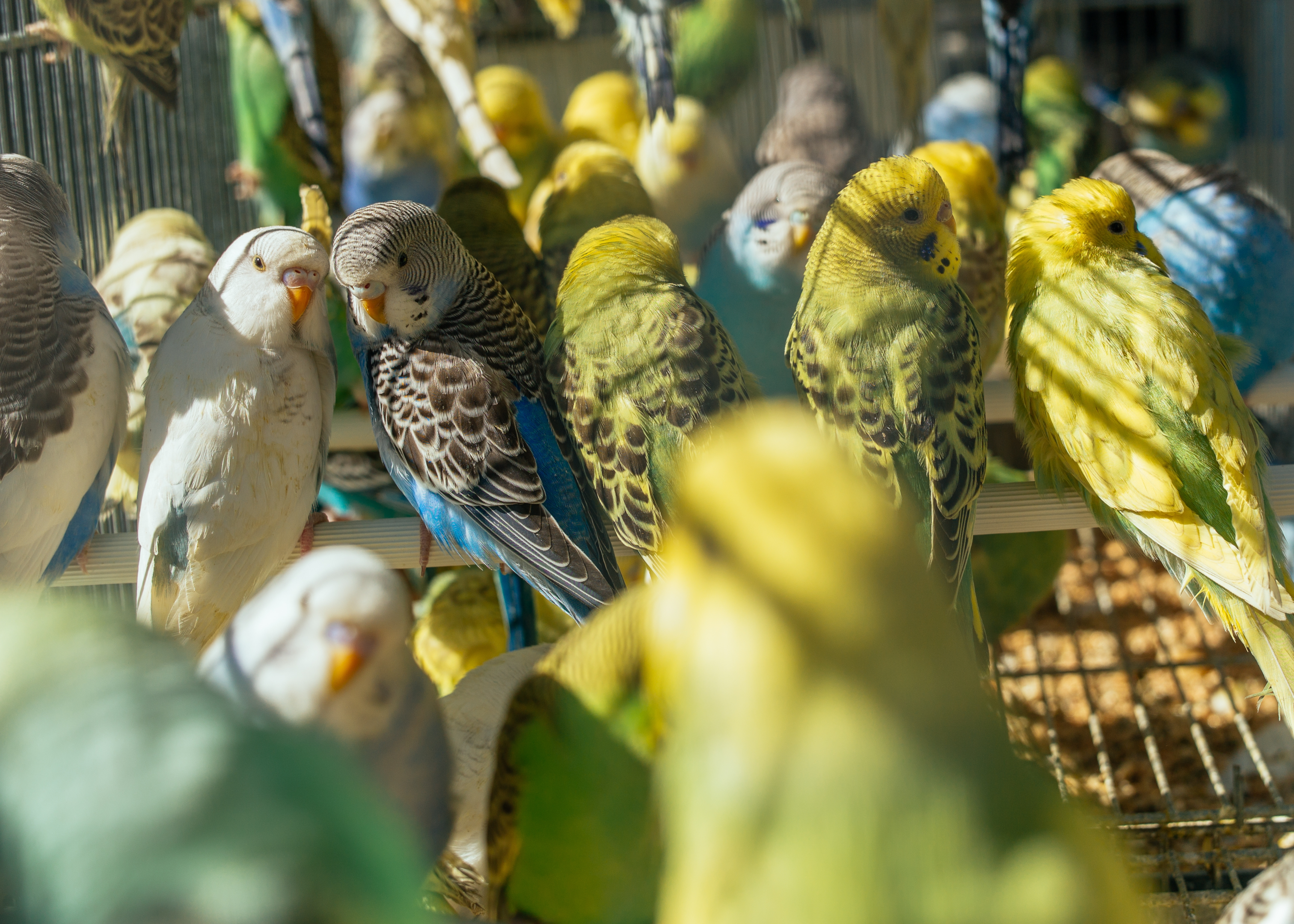
Selling parrots in Florida is indeed legal, but there are some hoops you need to jump through to do it by the book. First, you must snag a Class III Wildlife for Exhibition or Public Sale permit from the Florida Fish and Wildlife Conservation Commission (FWC). That’s your golden ticket to parrot sales. Before you get that permit, there are a couple of must-haves. Your criminal record should be squeaky clean, and you need to show that you’ve got the right facilities to care for these feathered friends properly. Safety and well-being are the name of the game here.
Once you’ve got your permit, you’re good to go. You can sell parrots to other licensed breeders, dealers, or even to the general public. But here’s the paperwork part – you’ve got to keep a record of every sale. That means jotting down the buyer’s name and address, the specific parrot species you sold, and the date of the sale. It’s all about staying transparent and accountable. However, it’s important to be aware that certain parrot species receive protection under the Endangered Species Act (ESA). Selling these parrots without a U.S. Fish and Wildlife Service permit is a no-no. So, while it’s legal to sell parrots, it’s crucial to know the rules and regulations, especially when it comes to those special, protected species.
Florida’s Fabulous 17: A Colorful Cast of Parrots
In a nutshell, Florida boasts a vibrant array of 17 parrot species, each with its unique charm. From the stunning Blue-and-Yellow Macaw to the quirky urban-dwelling Monk Parakeet, these feathered residents have added a touch of exotic beauty to the state’s landscape. However, as we admire their beauty and personalities, it’s crucial to consider their impact on the ecosystem and their conservation status. These parrots are indeed cherished and fascinating members of Florida’s local wildlife community.
Conclusion
In exploring wild parrot populations in Florida, we’ve uncovered a fascinating world of colorful and resilient birds. These parrots, originally arriving through the pet trade, have carved out a unique niche in the Sunshine State. Florida has a diverse range of parrot species, each with distinctive characteristics. Despite their non-native status, these parrots have thrived in their new environment, adding a touch of exotic beauty to the state’s natural landscape.
However, it’s essential to remember the legal considerations when it comes to parrots in Florida for sale. Obtaining the required permits and complying with regulations is crucial, particularly for protected species under the Endangered Species Act. Florida’s wild parrot populations let us appreciate this sunny paradise’s vibrant and unexpected residents and strive to protect and preserve their place in the unique tapestry of Florida’s wildlife.

FAQs
Are Parrots Invasive in Florida?
Yes, some species of parrots are considered invasive in Florida. The most notable invasive parrot species in Florida is the Monk Parakeet (Myiopsitta monachus), also known as the Quaker Parrot. These birds are native to South America but have established feral populations in several U.S. states, including Florida.
What is the Best Parrot for Talking?
The African Grey Parrot is widely considered the best parrot species for talking and mimicking human speech due to their exceptional vocal and cognitive abilities.
Embrace the Sunshine! Embark on an Unforgettable Florida Journey with Florida Splendors!

